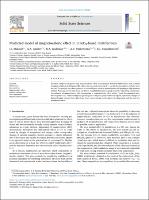Показать сокращенную информацию
Predicted model of magnetocaloric effect in BiFeO3-based multiferroics.
| dc.contributor.advisor | Английский | |
| dc.contributor.author | Makoed, I.I. | |
| dc.date.accessioned | 2021-12-22T11:33:24Z | |
| dc.date.available | 2021-12-22T11:33:24Z | |
| dc.date.issued | 2019-06-20 | |
| dc.identifier.citation | Makoed, I. I. Predicted model of magnetocaloric effect in BiFeO3-based multiferroics. I. I. Makoed, A. A. Amirov, N. A. Liedienov, A. V. Pashchenko, & K. I. Yanushkevich // Solid State Sciences. – 2019, V. 95. – P. 105920-1–105920-7. 105920.doi:10.1016/j.solidstatesciences.2019.06.009. | ru_RU |
| dc.identifier.uri | https://rep.brsu.by:443/handle/123456789/7443 | |
| dc.description.abstract | Structure, magnetic properties and magnetocaloric effect in synthesized Bi-based multiferroics with a partial isovalent substitution of bismuth (III) cations for rare-earth elements (R = La, Nd, Sm, Eu, Gd, Dy, Er) have been studied. The samples have been prepared by the solid-state reaction method under cold pressing at high pressure (4 GPa). Proposed, for the first time, has been a modified phenomenological model for describing temperature dependences of magnetization and investigating a magnetocaloric effect within “weak ferromagnetic-anti- ferromagnetic” and “antiferromagnetic-paramagnetic” magnetic phase transition regions. Systematic changes of thermodynamic characteristics have been found out to depend on the degree of replacement and the type of a substituted cation. | ru_RU |
| dc.language.iso | en | ru_RU |
| dc.publisher | Elsevier B.V | ru_RU |
| dc.subject | Multiferroics Rare-earth ion Magnetocaloric effect Relative cooling power Nйel temperature Magnetic phase transition | ru_RU |
| dc.title | Predicted model of magnetocaloric effect in BiFeO3-based multiferroics. | ru_RU |
| dc.type | Article | ru_RU |
